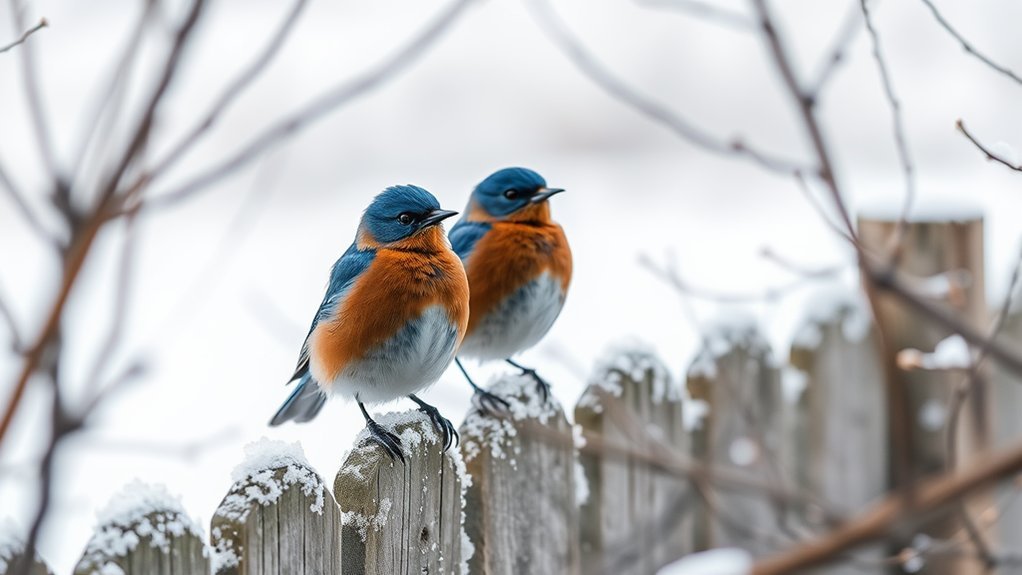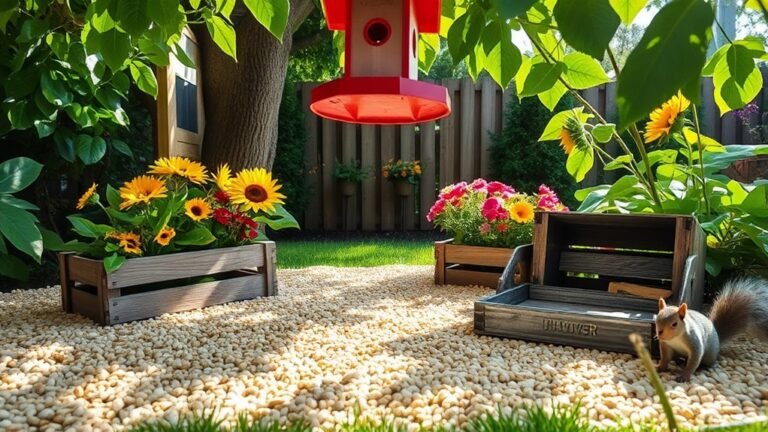Eastern Bluebirds in Winter: Survival Guide
Eastern bluebirds face challenges in winter. They adapt to survive cold weather. For warmth and safety, they form social groups. They also choose habitats that protect them from harsh conditions. These behaviors show their resilience and the importance of support for their survival.
In winter, their diet changes, focusing on different food sources. You can help these beautiful birds by providing food and safe spaces. Understanding their winter strategies can enhance your appreciation for these vibrant creatures.
Key Takeaways
- Eastern Bluebirds adapt to winter by gathering in small groups. They do this for socialization and to protect themselves from predators in warmer areas.
- Their diet changes during winter. They eat more berries and seeds, with plants like holly and dogwood being important food sources.
- To stay warm, they roost in tree cavities and puff up their feathers. This helps them keep body heat during cold weather.
- You can identify them by their bright colors and characteristic flutter while they forage for food.
- Community efforts can help bluebird populations. Providing nesting boxes and planting native plants supports these birds in urban areas.
The Resilience of Eastern Bluebirds

Eastern Bluebirds show strong resilience during winter. Instead of migrating long distances like other birds, they often choose to stay in warmer areas. This choice helps them find food, mostly berries and insects, that remain available in colder months.
Eastern Bluebirds also form small groups to socialize and protect each other. By banding together, they increase their survival chances against predators and make better use of food resources.
These behaviors highlight how adaptable Eastern Bluebirds are, proving they can thrive despite the difficulties winter brings.
Winter Adaptations and Behaviors
Eastern Bluebirds have specific winter adaptations that help them survive cold weather. Their feathers act as insulation; they puff up their feathers to trap air, which keeps them warm.
They also change their behavior by roosting together in tree cavities to retain heat.
Their feeding habits adjust to winter conditions as well. They search for berries and seeds, which are plentiful during this season. This varied diet supports their energy needs during harsh weather.
Identifying Eastern Bluebirds in Cold Weather

Identifying Eastern Bluebirds in cold weather involves careful observation of their unique features in the winter landscape.
Look for their bright colors against the dull browns and grays of winter. Male bluebirds have vivid blue wings and an orange breast, while females have softer colors but retain the same shape.
Observe their behavior: they often sit on fences or low branches, watching for insects or berries.
When they forage, they may perform a noticeable flutter, which can help you spot them among other birds.
Listen for their gentle, melodious calls; this sound brings warmth to the cold air.
Enjoying these charming birds adds to the beauty of winter.
Preferred Winter Habitats
Eastern Bluebirds prefer specific winter habitats that fit their needs. These birds often choose urban areas, adapting well to human environments.
You can find them in parks and open fields, where they've good foraging options and safe places to rest. They also like forest edges, which provide cover and access to insects and fruit. These resources are vital for their survival in winter.
In these areas, they can hunt in the open while having protection from bad weather and predators. By focusing on these urban and natural intersections, you can increase your chances of spotting Eastern Bluebirds during winter.
Enjoy the search for these lively birds in their winter homes!
Food Sources During Winter Months

During winter, bluebirds need a varied diet to stay alive. Their food mainly includes insects, berries, and fruits. In cold weather, insects are hard to find, so bluebirds turn to other food sources. This shows how adaptable they are.
In areas with many fruits, bluebirds do well. They often stay near shrubs full of berries like holly and dogwood. They search for food during the cold months, proving that a mixed diet is crucial for their survival.
You can help bluebirds by placing feeders with mealworms and suet. This support can help them survive winter.
Nesting and Roosting Strategies
As winter approaches, bluebirds use specific nesting and roosting strategies to survive.
They look for warm and safe roosting sites that protect them from cold temperatures. Common roosting sites include:
- Hollow trees or tree cavities
- Dense shrubs or thickets
- Old barn eaves or other structures
- Nest boxes provided by birdwatchers
To prepare these sites, bluebirds collect materials like grass, feathers, and moss.
They create a cozy environment that keeps them warm. This behavior shows their instinct for survival.
The Importance of Natural Cover
Natural cover is essential for the survival of Eastern bluebirds during winter. It provides shelter that helps them withstand cold weather. Dense shrubs, trees, and grasses protect them from harsh winds, snow, and rain.
This natural environment offers hiding spots from predators and helps them maintain their body heat.
Creating or maintaining natural cover in your yard encourages bluebirds to thrive. By planting native plants, you support their survival and enhance your backyard experience.
This connection to nature fosters a sense of belonging in the ecosystem. Enjoy the beauty of bluebirds while knowing you're helping them live safely through winter months.
Social Dynamics in Winter Flocks
Eastern bluebirds adapt to winter conditions by forming structured flocks. These flocks have a clear hierarchy that influences interactions and access to food.
- Dominant bluebirds occupy the best feeding locations.
- Subordinate birds exhibit submissive behaviors to avoid conflict.
- Young bluebirds learn by watching others, helping them understand their role in the group.
- Regular calls strengthen their bond and keep the flock together.
These social interactions create a sense of community during cold weather. Each bird plays a role in maintaining group dynamics, contributing to collective survival.
This cooperation helps them find food and offers protection from threats, proving essential for winter survival.
Tips for Birdwatching in Winter
Enhance your winter birdwatching experience with these helpful tips.
Start by acquiring the right gear. A good pair of binoculars helps you see Eastern Bluebirds from afar, while a field guide assists in identifying them. A notebook is useful for recording your bird sightings.
Dress warmly to stay comfortable. Layer your clothing to manage heat effectively, and wear insulated gloves to keep your hands warm while you write or adjust your equipment.
Arrive early to find birds feeding in the morning light. Choose a quiet spot with natural cover to observe bird behaviors without causing disturbance.
Enjoy the beauty of winter birdwatching!
Creating a Bird-Friendly Environment
Creating a bird-friendly environment improves your winter birdwatching experience. To draw Eastern Bluebirds and other winter birds, use these elements:
- Bird Feeders: Install feeders with sunflower seeds and mealworms. These foods suit bluebirds in winter.
- Native Plants: Choose local plants that produce fruits and seeds. They provide natural food and shelter for birds.
- Water Sources: Place a heated birdbath for fresh water. Birds need hydration, especially in cold weather.
- Landscaping: Include shrubs and small trees. They offer safe perches and nesting areas for birds.
Common Threats to Eastern Bluebirds in Winter
As winter arrives, Eastern Bluebirds face many challenges that affect their survival. One major issue is habitat loss. Urban development and agricultural growth reduce the natural areas where the birds forage and nest. Without these spaces, bluebirds find it hard to get food and shelter.
Additionally, winter increases the risk of predation. With fewer leaves on trees and shrubs, bluebirds become more visible to predators like cats and birds of prey. This visibility makes it harder for them to avoid danger.
These factors can lead to higher mortality rates for bluebirds. It's important to understand these threats to help maintain healthy bluebird populations and support their survival strategies during winter.
Supporting Eastern Bluebirds Through Conservation Efforts
Eastern Bluebirds face many challenges during winter, but you can help them survive with your support.
Here are some simple actions you can take:
- Support habitat preservation efforts to protect natural spaces.
- Get involved with or donate to local conservation programs that focus on bluebirds.
- Create friendly spaces for bluebirds by installing nesting boxes in your area.
- Teach your community about the importance of native plants that provide food for these birds.
Your efforts can make a big difference in the lives of Eastern Bluebirds.
Together, we can help them thrive.
Frequently Asked Questions
Do Eastern Bluebirds Migrate During the Winter?
Eastern bluebirds migrate during the winter. Some stay in their breeding areas, while others move south to find warmer climates. These movements depend on food availability and weather conditions. Observing their migration patterns can deepen your appreciation for their adaptability and resilience.
What Are the Main Predators of Eastern Bluebirds in Winter?
In winter, Eastern Bluebirds deal with serious threats from predators, primarily hawks. These hawks can attack quickly, posing a risk to the bluebird population. As a result, Eastern Bluebirds remain alert and change their behavior to better avoid these predators. Understanding these threats helps in appreciating the resilience of these beautiful birds.
How Long Do Eastern Bluebirds Typically Live?
Eastern bluebirds usually live for about 2 to 3 years. Some can live up to 6 years. Their lifespan depends on factors like habitat quality, food availability, and the risks from predators. These factors are important to consider in bluebird conservation efforts.
Can Eastern Bluebirds Tolerate Extreme Cold Temperatures?
Eastern Bluebirds can have difficulty with extreme cold. To survive harsh winter conditions, they find shelter and group together. These actions help them increase their chances of staying warm and safe during cold weather.
What Can I Do if I Find an Injured Bluebird?
If you find an injured bluebird, contact local rescue organizations right away. These organizations help with injured wildlife and can provide the support the bird needs. It is important not to handle the bird on your own, as proper care is essential for its recovery.

Ava is a bird enthusiast and nature lover who has spent countless hours observing and learning about the fascinating world of birds. With a passion for sharing her knowledge and inspiring others to appreciate the beauty of birds, Ava writes about her experiences and insights on avianadmirer.com.







